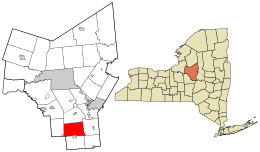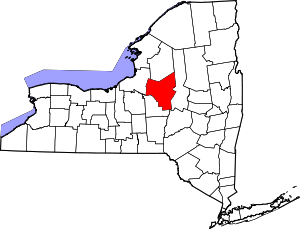Marshall, New York
| Marshall, New York | |
|---|---|
| Town | |
 Location in Oneida County and the state of New York. | |
| Coordinates: 42°57′50″N 75°23′36″W / 42.96389°N 75.39333°WCoordinates: 42°57′50″N 75°23′36″W / 42.96389°N 75.39333°W | |
| Country | United States |
| State | New York |
| County | Oneida |
| Government | |
| • Type | Town Council |
| • Town Supervisor | Morris Sturdevant (R) |
| • Town Council |
Members' List
|
| Area | |
| • Total | 32.8 sq mi (85.0 km2) |
| • Land | 32.8 sq mi (85.0 km2) |
| • Water | 0.0 sq mi (0.0 km2) |
| Elevation | 1,158 ft (353 m) |
| Population (2010) | |
| • Total | 2,131 |
| • Density | 65/sq mi (25/km2) |
| Time zone | Eastern (EST) (UTC-5) |
| • Summer (DST) | EDT (UTC-4) |
| FIPS code | 36-45755 |
| GNIS feature ID | 0979201 |
Marshall is a town in Oneida County, New York, United States. The population was 2,131 at the 2010 census.
The Town of Marshall is in the southeast part of the county. Marshall is southwest of Utica, New York.
History
The first settlers were the Brothertown Indians, a tribe formed from scattered remnants of tribes from New England, led by Asa Dick and Samson Occum, around 1774. They were granted land by the Oneida Indians, for the purpose of creating a new township for Christian Indians. They made their homes around the Oriskany Creek, which provided power for their grist mills. The first white settlers arrived in 1794 and settled in the higher regions, in Hanover and the west hills. The town was formed in 1829 from the Town of Kirkland.
Geography
According to the United States Census Bureau, the town has a total area of 32.8 square miles (85 km2), all of it land.
Part of the south town line is the border of Madison County, New York.
Demographics
| Historical population | |||
|---|---|---|---|
| Census | Pop. | %± | |
| 1830 | 1,908 | — | |
| 1840 | 2,251 | 18.0% | |
| 1850 | 2,115 | −6.0% | |
| 1860 | 2,134 | 0.9% | |
| 1870 | 2,145 | 0.5% | |
| 1880 | 2,276 | 6.1% | |
| 1890 | 2,145 | −5.8% | |
| 1900 | 1,804 | −15.9% | |
| 1910 | 1,744 | −3.3% | |
| 1920 | 1,490 | −14.6% | |
| 1930 | 1,431 | −4.0% | |
| 1940 | 1,541 | 7.7% | |
| 1950 | 1,616 | 4.9% | |
| 1960 | 1,902 | 17.7% | |
| 1970 | 2,072 | 8.9% | |
| 1980 | 2,131 | 2.8% | |
| 1990 | 2,125 | −0.3% | |
| 2000 | 2,127 | 0.1% | |
| 2010 | 2,131 | 0.2% | |
| Est. 2014 | 2,128 | [1] | −0.1% |
As of the census[3] of 2000, there were 2,127 people, 786 households, and 579 families residing in the town. The population density was 64.8 people per square mile (25.0/km²). There were 829 housing units at an average density of 25.3 per square mile (9.8/km²). The racial makeup of the town was 98.54% White, 0.52% African American, 0.14% Asian, 0.05% from other races, and 0.75% from two or more races. Hispanic or Latino of any race were 0.80% of the population.
There were 786 households out of which 36.1% had children under the age of 18 living with them, 60.1% were married couples living together, 8.9% had a female householder with no husband present, and 26.3% were non-families. 21.9% of all households were made up of individuals and 7.8% had someone living alone who was 65 years of age or older. The average household size was 2.71 and the average family size was 3.16.
In the town the population was spread out with 28.0% under the age of 18, 7.9% from 18 to 24, 29.0% from 25 to 44, 24.2% from 45 to 64, and 11.0% who were 65 years of age or older. The median age was 37 years. For every 100 females there were 99.3 males. For every 100 females age 18 and over, there were 98.2 males.
The median income for a household in the town was $42,125, and the median income for a family was $47,214. Males had a median income of $31,150 versus $24,196 for females. The per capita income for the town was $19,133. About 6.8% of families and 10.1% of the population were below the poverty line, including 13.8% of those under age 18 and 7.0% of those age 65 or over.
Communities and locations in Marshall
- Brothertown – A location in the southwest part of the town, northwest of Waterville. Locally known for accommodating Native Americans before and during local settlement. Waterville Central School's football and outdoor soccer facility was named Brothertown Stadium and Waterville's mascot is an Indian.
- Daytonville – A hamlet northwest of the Marshall hamlet.
- Deansboro – A hamlet on NY 12B in the northwest part of the town. Location of the town government.
- Forge Hollow – A hamlet northwest of Waterville, located on NY 315.
- Hanover – A hamlet west of the Marshall hamlet and north of Waterville.
- Hubbard Corners – A location northwest of Marshall, located on NY 12.
- Lewis Corners – A location west of the Marshall hamlet.
- Marshall – The hamlet of Marshall is near the east town line.
- McConnell Corners – A location near the north town line.
- Oriskany Falls – The Village of Oriskany Falls is at the southwest corner of the town.
- Peck Corners – A location north of Daytonville.
- Small Corners – A hamlet south of Deansboro.
- Tassel Hill – Highest point in Oneida County. Located in the eastern part of the town, east of Route 12 on the borders of the towns of Bridgewater, Paris, and Sangerfield.
- Waterville – The north part of the Village of Waterville is on the south town line.
References
- ↑ "Annual Estimates of the Resident Population for Incorporated Places: April 1, 2010 to July 1, 2014". Retrieved June 4, 2015.
- ↑ "Census of Population and Housing". Census.gov. Retrieved June 4, 2015.
- ↑ "American FactFinder". United States Census Bureau. Retrieved 2008-01-31.
